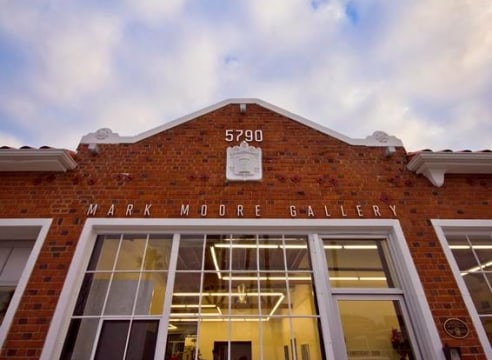
Richard Prince (b. 1949) was born in the Panama Canal Zone and grew up in the Boston suburb that his parents settled in five years later. In 1973, he moved to New York, where he immersed himself in the downtown music and art scenes. While working in the tear-sheet department of Time Life, he began to photograph the discarded advertising pages, carefully cropping out all copy until he was left with only formulaic images of consumer aspiration such as watches, fountain pens, interior decor, logos, and fashion models. He subsequently focused his camera on a series of stock figures so hopelessly clichéd that they can be described as one-word archetypes: cowboys, girlfriends, and entertainers. These appropriated images were displayed individually or sometimes grouped within a single frame in a format that the artist refers to as a “gang.” Simultaneously, Prince began to appropriate old jokes from the annals of borscht-belt humor, pairing them with renderings of unrelated, equally raunchy cartoons or spelling them out on otherwise empty, monochrome backgrounds.
As his career has progressed, Prince has brought an increasingly expressionistic sensibility to bear on his appropriated imagery and texts, producing resolutely painterly canvases. Although still present, the jokes are now muted by gestural fields of layered paint and, in some cases, are part of compositions containing snippets of scribbled drawings or collaged bank checks. A similar development can be marked in Prince’s sculptural works. His Hoods—painted muscle-car hoods, which either sit on pedestals or hang, relief-like, from the wall—initially sported a slick, commercial finish. Now, their surfaces are hand-painted, matte, and almost atmospheric in appearance. In 2003 the artist premiered his Nurses, a series of canvases derived from the pulpy cover designs of medical romance novels and rendered in dripping, lurid colors save for each nurse’s white uniform and surgical mask. Prince’s latest body of work focuses on the paintings of venerated Abstract Expressionist artist Willem de Kooning and blends elements from de Kooning’s famous Women paintings with figures cut from magazines—creating works that are hybrids of both men and women, and photographs and paintings.
In recent years Prince has drawn inspiration from the small-town milieu of his current base in upstate New York, which he has documented in a series of original photographs that characterize the local vernacular: backyard basketball hoops, above-ground swimming pools, rusting vehicles, and the like. The move upstate allowed Prince to extend his practice of creating environmental installations, previous examples of which include the Spiritual America gallery in downtown Manhattan (1983–84) and the First House installation in Los Angeles (1993). In yet another act of appropriation Prince transformed a ranch-style residence in Rensselaerville into his Second House (2001–07), an installation designed specifically to showcase a suite of Hoods and related works. Camouflaged as a perpetual work in progress—the exterior clad in exposed insulation material, and the interior walls and ceilings stripped to the drywall—the house easily resembled other dwellings in this depressed corner of Albany County. Second House was damaged when lightning struck the building and started a fire, and the artist is currently working on creating a new structure for the site. In addition, a private library of rare books and first editions and a fully operational body shop are part of Prince's network of projects upstate.